Etiology
Pathology involving the tongue, floor of mouth, palate, tonsils, or other oral cavity structures can lead to oral phase dysphagia. The problem in this scenario is often recognized as difficulty with initiating the swallow.
Pharyngeal disorders can cause dysphagia when dysfunction of the base of tongue, pharynx, larynx, or cricopharyngeal muscle occurs. This may be manifest by reports of food sticking in the throat, symptoms of aspiration, hoarseness, cough, pain in the throat, or even referred pain to the ear.
Esophageal dysphagia may be as a result of esophageal motility disorders, intrinsic or extrinsic masses, webs, rings, reflux disease, or lower esophageal sphincter disorders. These pathologies will more likely present with sensation of food sticking in the lower aspect of the neck or chest, regurgitation of food, chest pain, or heartburn.
Dysphagia is often multifactorial in nature. For example, an elderly patient may have weak pharyngeal musculature, with cervical osteophytes and esophageal reflux. Each issue alone may not be problematic, but combined they may cause significant dysphagia.
Oropharyngeal infection/inflammation
Infections such as pharyngitis, esophageal candidiasis, epiglottitis, and retropharyngeal abscess can cause dysphagia, as can radiation- and/or chemotherapy-induced oral mucositis.[9]
Oral cavity structural abnormalities
Hypertrophic tonsils
Causes dysphagia for solids by interfering with transfer of bolus from oral cavity to pharynx.
May be associated with obstructive sleep apnea, recurrent infections, and snoring.
Lingual tonsils (at the base of the tongue) may be difficult to visualize but may also become hypertrophic and interfere with swallowing. Can be visualized with flexible nasopharyngoscopy or indirect laryngoscopy with a dental mirror.[Figure caption and citation for the preceding image starts]: Hypertrophic tonsilsFrom the collection of Dr S. Charous [Citation ends].
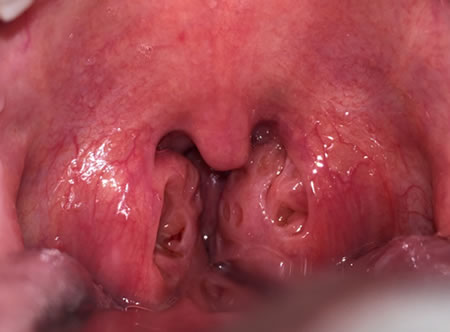 [Figure caption and citation for the preceding image starts]: Hypertrophic tonsilsFrom the collection of Dr S. Charous [Citation ends].
[Figure caption and citation for the preceding image starts]: Hypertrophic tonsilsFrom the collection of Dr S. Charous [Citation ends]. [Figure caption and citation for the preceding image starts]: Hypertrophic tonsils causing severely narrowed pharyngeal openingFrom the collection of Dr S. Charous [Citation ends].
[Figure caption and citation for the preceding image starts]: Hypertrophic tonsils causing severely narrowed pharyngeal openingFrom the collection of Dr S. Charous [Citation ends].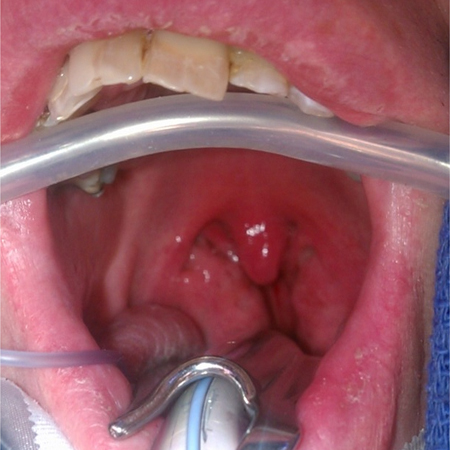
Oral cavity tumors (especially cancers)
Can affect any of the structures in the oral cavity and become large enough to cause obstruction and prevent food passage.
Can affect function of any of the structures by invasion into surrounding tissue: for example, carcinoma of the tongue with floor of mouth invasion that leads to impaired tongue mobility resulting in difficulty swallowing.
More common in smokers and alcohol drinkers.
Becoming more common in nonsmokers because of human papillomavirus-induced squamous cell carcinomas involving the tonsils and base of the tongue.
Often associated with pain, altered speech, neck mass, or bloody sputum.
Dentition
Edentulous patients or patients with poor dentition may have difficulty chewing food and may therefore be unable to form an appropriately sized food bolus to be transferred into the pharynx.
Oropharyngeal structural abnormalities
Zenker diverticulum
Located proximal to upper esophageal sphincter.
The incidence increases by age; more frequent in women.
Prevalence 50% in seventh and eighth decades.
Is associated with regurgitation of undigested food, intermittent solid food dysphagia, halitosis, and excessive salivation.
Barium swallow is the best diagnostic test.[Figure caption and citation for the preceding image starts]: Zenker diverticulum: lateral view with barium esophagramFrom the collection of Dr S. Charous, Clinical Professor of Otolaryngology - Head and Neck Surgery, Loyola University Medical Center; used with permission. [Citation ends].

Can be missed or difficult to visualize on esophageal endoscopy.[10]
Pharyngeal/laryngeal tumors
Symptoms may include progressive solid food dysphagia, weight loss, and otalgia (referred pain).
Hoarseness, symptoms of aspiration (especially of liquids), and shortness of breath are often associated with laryngeal tumors.
Vast majority of malignancies are squamous cell carcinomas; often very aggressive when this is the primary site with frequent metastases.
Endoscopy with biopsy is the best diagnostic test.[11][Figure caption and citation for the preceding image starts]: Laryngeal/pharyngeal squamous cell carcinomaFrom the collection of Dr S. Charous [Citation ends].
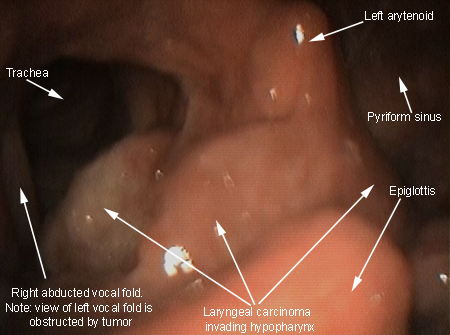
Stenosis
Mostly caused by prior radiation, surgery, or chemical ingestion.
May be idiopathic, but this is rare.
Presents as solid food dysphagia or symptoms of aspiration.
Flexible fiberoptic nasopharyngoscopy/laryngoscopy, esophagogastroduodenoscopy (EGD), and barium swallow are helpful.
Extrinsic compression
Cervical lymphadenopathy, cricopharyngeal bar, cervical spine osteophytes, or thyromegaly.[Figure caption and citation for the preceding image starts]: Endoscopic view of pharynx showing osteophytes pressing inward on posterior pharyngeal wall, obscuring view of larynx with epiglottis in backgroundFrom the collection of Dr S. Charous [Citation ends].
 [Figure caption and citation for the preceding image starts]: Lateral x-ray during barium swallow, demonstrating osteophytes displacing flow of barium in upper esophagusFrom the collection of Dr S. Charous [Citation ends].
[Figure caption and citation for the preceding image starts]: Lateral x-ray during barium swallow, demonstrating osteophytes displacing flow of barium in upper esophagusFrom the collection of Dr S. Charous [Citation ends]. [Figure caption and citation for the preceding image starts]: Thyroid tumor compressing cervical esophagusFrom the collection of Dr S. Charous [Citation ends].
[Figure caption and citation for the preceding image starts]: Thyroid tumor compressing cervical esophagusFrom the collection of Dr S. Charous [Citation ends].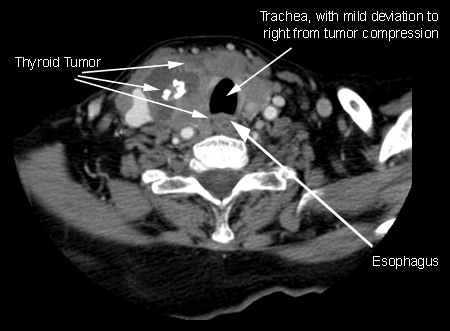
Flexible fiberoptic nasopharyngoscopy/laryngoscopy and barium swallow can usually identify the defect.
Oropharyngeal neuromuscular abnormalities
Neuromuscular discoordination, involving the central nervous system or the peripheral nervous system, can result in oral or pharyngeal dysphagia.[12] Neurologic exam and evaluation of neurologic symptoms are helpful in directing the physician to the underlying etiology of the dysfunction. The following are common neuromuscular causes of oral or pharyngeal dysphagia; stroke in this group is the most common cause:
Stroke: some 40% to 70% of people with stroke experience dysphagia[2]
Amyotrophic lateral sclerosis
Multiple sclerosis
Vocal cord paralysis
Brain and skull base tumors
Postoperative resections of skull base or brain tumors (especially and often involving cranial nerves IX, X, and XII)
Sjogren syndrome[15]
Myasthenia gravis
Inflammatory myopathies
Wilson disease
Progressive supranuclear palsy
Oculopharyngeal muscular dystrophy
Muscle tension dysphagia, which describes excessive laryngeal and pharyngeal tension that disrupts swallowing; it is a diagnosis of exclusion made with speech therapists and cannot yet be diagnosed with conventional testing.[16]
Esophageal structural abnormalities
Stricture
The main symptom is solid food dysphagia.
EGD or barium esophagrams are the best diagnostic test.
Dysphagia is most prevalent when the luminal diameter is <15 mm (normal is 20 mm).[17]
Acid reflux accounts for 60% to 70% of cases of strictures and mainly occurs in the region of the lower esophageal sphincter.[18]
Caustic agents and radiation therapy may lead to strictures.
Pills such as potassium chloride, doxycycline, quinidine, nonsteroidal anti-inflammatory drugs, iron, and alendronate may cause strictures.[19]
Intramural lesions
Foreign body: acute dysphagia could occur as a result of foreign bodies and food impaction in the esophagus. These most often will obstruct at the level of the upper or lower esophageal sphincters.
Esophageal/cardia carcinomas: patients typically present with reflux in early disease, and dysphagia and odynophagia in locally advanced or late disease.[20] Dysphagia alone or with unintentional weight loss is the most common presenting symptom.[21] Adenocarcinoma and squamous cell carcinoma account for over 95% of all cases of esophageal cancer.[21] Squamous cell carcinoma is often associated with alcohol and tobacco consumption, and with human papillomavirus infection; adenocarcinoma with gastroesophageal reflux disease (GERD), Barrett esophagus, high body mass index, and male sex.[20] Approximately 75% of all esophageal adenocarcinomas are located in the distal esophagus, whereas squamous cell carcinomas occur more frequently in the proximal-to-middle esophagus.[22][23] EGD with biopsy is usually diagnostic.[24]
Benign tumors: rare; include leiomyoma, granular cell tumors, and papillomas.
Esophageal metastases: metastasis to the esophagus is rare, but most frequently occurs in the context of advanced lung or breast cancer. Other possible primary carcinomas include ovarian and colonic cancer.[25]
Extramural lesions compressing the esophagus
Mediastinal masses
Bronchial carcinoma
Cervical osteoarthritis/cervical osteophytes[26]
Patients usually have symptoms of underlying disease with recently added solid food dysphagia
Best diagnosed with barium study.[11]
Esophageal ring
Manifest by intermittent solid food dysphagia; if found, presumed to be the cause of symptoms.
Mucosal ring (Schatzki ring): prevalence of 0.2% to 1.4%. Located at gastroesophageal junction.
Muscular rings: located 1.5 cm proximal to the gastroesophageal junction. Typically asymptomatic.[27]
Anatomic abnormalities
Esophageal diverticulum: known as traction diverticulum secondary to pulling of the esophageal wall. Located in the middle third of the esophagus. Barium study is the most useful test to identify them.
Hiatal hernia: is typically asymptomatic, associated with GERD, and can cause bleeding and incarceration.
Webs: found in 5% to 15% of patients with benign causes of dysphagia who undergo EGD.[27]
Esophageal motor abnormalities
Idiopathic achalasia
Esophageal motility disease with insufficient lower esophageal sphincter relaxation and loss of esophageal peristalsis.
Progressive dysphagia to solids followed by liquids is seen in 82% to 100% of patients.
Esophageal manometry is useful in detecting motility abnormalities of achalasia.[28][29][30][31]
Scleroderma
Causes esophageal hypomotility and incompetence of lower esophageal sphincter.
Can lead to chronic gastroesophageal reflux with subsequent stricture formation.
Esophageal manometry along with clinical correlation is helpful in diagnosis.[32]
Diffuse esophageal spasm
Mostly manifest by recurrent chest pains associated with meals.
More common with ingestion of very hot or very cold foods.
Is diagnosed by manometry, which reveals simultaneous contractions.[29][30][31][33]
Finding on barium swallow study is “corkscrew” esophageal body from a simultaneous contraction.[29][Figure caption and citation for the preceding image starts]: Corkscrew esophagus from diffuse esophageal spasm seen on a barium swallow studyFrom the collection of Dr S. Charous [Citation ends].
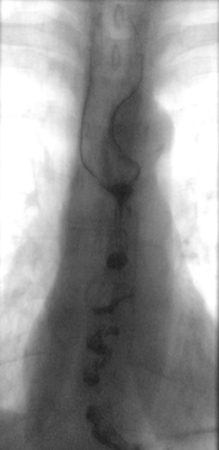
Hypocontracting esophagus
Ineffective esophageal motility with low amplitude, poorly coordinated peristalsis.
Hypotensive lower esophageal sphincter.
Gastroesophageal reflux is significant and can lead to strictures.
Dysphagia is usually mild.
Nutcracker esophagus
Is associated with chest pain.
Normal peristalsis with increased distal esophageal mean amplitudes and hypertensive lower esophageal sphincter.
Eosinophilic esophagitis
Chronic immune-mediated condition often associated with concurrent allergic diseases including food allergies, allergic rhinitis, atopic dermatitis, or asthma.[35][36]
Three times more common in men than in women.[36][37][38] Eosinophilic esophagitis appears to be more common in white people than in African-Americans or Asian people.[39][40] The peak incidence is seen in young adults and in the third and fourth decades of life.[36][37]
Patients may present with dysphagia, heartburn, chest pain, acute food impaction, and/or associated other symptoms consistent with gastroesophageal reflux.[35]
EGD shows multiple esophageal rings with narrowing and decreased distensibility of esophageal lumen from submucosal fibrosis and remodeling.[35]
Diagnosis is confirmed with biopsy of the esophageal mucosa during endoscopy.[36][41][42][43][44] In the US, at least 2-4 biopsies are taken; at least 6 biopsies are recommended in Europe.[36][43][44]
Use of this content is subject to our disclaimer